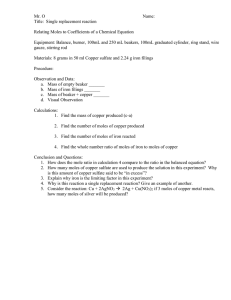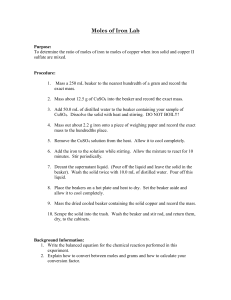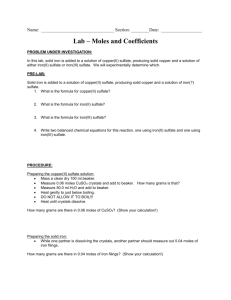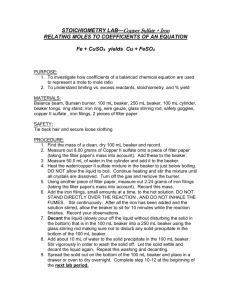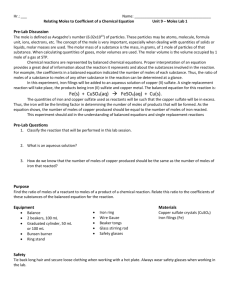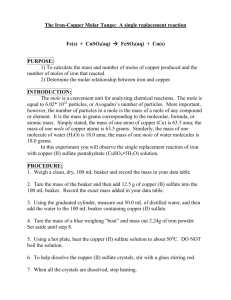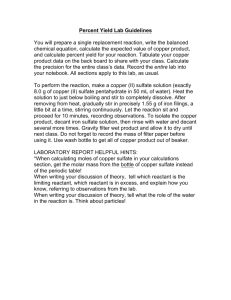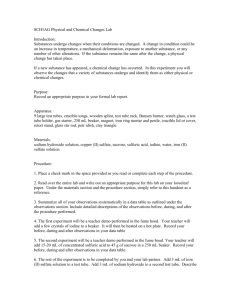Alchemist Lab Instructions and Questions
advertisement
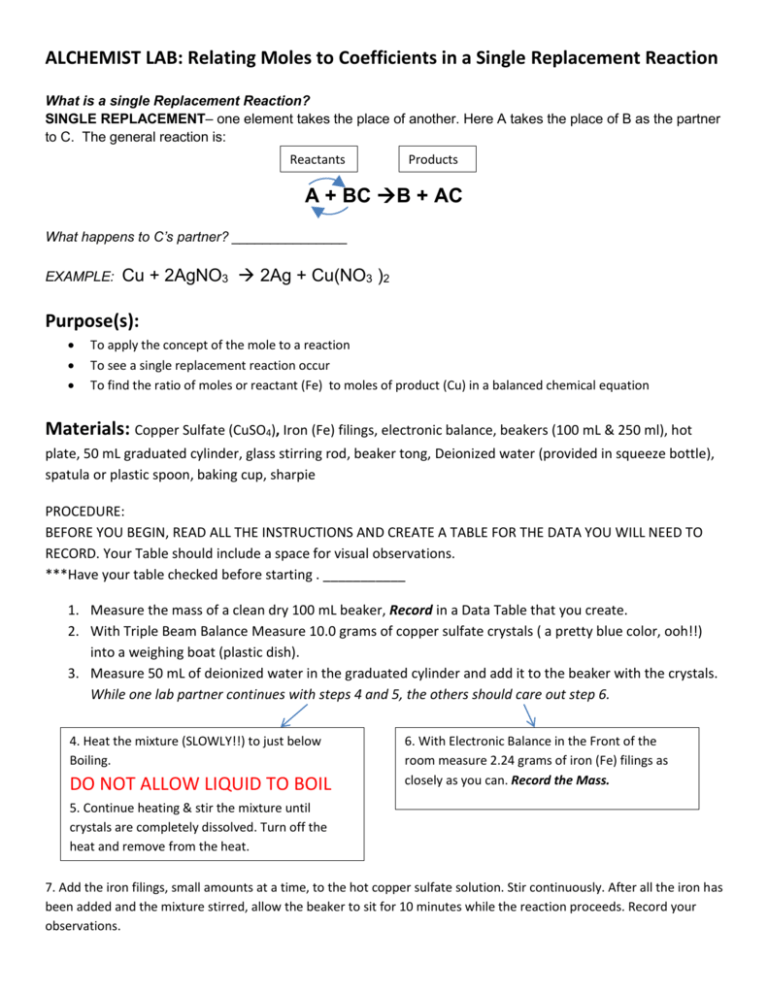
ALCHEMIST LAB: Relating Moles to Coefficients in a Single Replacement Reaction What is a single Replacement Reaction? SINGLE REPLACEMENT– one element takes the place of another. Here A takes the place of B as the partner to C. The general reaction is: Reactants Products A + BC B + AC What happens to C’s partner? _______________ EXAMPLE: Cu + 2AgNO3 2Ag + Cu(NO3 )2 Purpose(s): To apply the concept of the mole to a reaction To see a single replacement reaction occur To find the ratio of moles or reactant (Fe) to moles of product (Cu) in a balanced chemical equation Materials: Copper Sulfate (CuSO4), Iron (Fe) filings, electronic balance, beakers (100 mL & 250 ml), hot plate, 50 mL graduated cylinder, glass stirring rod, beaker tong, Deionized water (provided in squeeze bottle), spatula or plastic spoon, baking cup, sharpie PROCEDURE: BEFORE YOU BEGIN, READ ALL THE INSTRUCTIONS AND CREATE A TABLE FOR THE DATA YOU WILL NEED TO RECORD. Your Table should include a space for visual observations. ***Have your table checked before starting . ___________ 1. Measure the mass of a clean dry 100 mL beaker, Record in a Data Table that you create. 2. With Triple Beam Balance Measure 10.0 grams of copper sulfate crystals ( a pretty blue color, ooh!!) into a weighing boat (plastic dish). 3. Measure 50 mL of deionized water in the graduated cylinder and add it to the beaker with the crystals. While one lab partner continues with steps 4 and 5, the others should care out step 6. 4. Heat the mixture (SLOWLY!!) to just below Boiling. DO NOT ALLOW LIQUID TO BOIL 6. With Electronic Balance in the Front of the room measure 2.24 grams of iron (Fe) filings as closely as you can. Record the Mass. 5. Continue heating & stir the mixture until crystals are completely dissolved. Turn off the heat and remove from the heat. 7. Add the iron filings, small amounts at a time, to the hot copper sulfate solution. Stir continuously. After all the iron has been added and the mixture stirred, allow the beaker to sit for 10 minutes while the reaction proceeds. Record your observations. 8. Decant (that is like pouring slowly) the liquid into a 250 mL beaker as shown in the diagram. Do your best not to disturb the solid at the bottom of the beaker. 9. Add about 10 mL of deionized water to the solid in the 100 mL beaker. Stir vigorously in order to wash off the solid. Let the solid settle and decant the liquid. Repeat the washing. 10. Spread out the solid on the bottom of the beaker (without losing any) and place the beaker in a drawer or oven to dry. Complete Step 11 and the rest of the experiment at the beginning of the next class period. 11. Measure the mass of the beaker and the dry (Is it really perfectly dry? ) copper metal. Record this as your final data. Calculations: 1. Find the mass of the copper produced (Show the calculation) 2. Find the number of moles of copper produced (Look up the MM of Copper and show the calculation with all units, check your work with your EXCEL Chem Calculator) 3. Find the number of moles of Iron reacted: (Look up the MM of Iron and show the calculation with all units, check your work with your EXCEL Chem Calculator) 4. Using the moles of Iron reacted as the theoretical result and the moles of copper as the experimental result, calculate the percent error. (Do you recall the equation for % Error?) 5. Find the whole number ratio of moles of iron to moles of copper, 𝑚𝑜𝑙𝑒𝑠 𝑜𝑓 𝐹𝑒 𝑚𝑜𝑙𝑒𝑠 𝑜𝑓 𝐶𝑢 = LAB QUESTIONS: (These must be reproduced in your lab journal) 1. What is the balanced chemical reaction for this reaction? How does the ratio found in calculation 5 compare with the ratio of coefficients of the same two metals in the balanced chemical equation for the reaction? 2. How many moles of copper sulfate are used to produce the solution in this experiment (look up MM of copper sulfate)? Why is the amount of copper sulfate said to be in excess? 3. Explain why Iron is the limiting factor in the reaction. 4. A general description of the single replacement reaction is given at the start of this experiment. Based on this and the experimental results give a balanced equation for the reaction that occurred in this experiment. 5. Consider the reaction: Cu (s) + 2AgNO3 (aq) 2Ag (s) + Cu(NO3)2 (aq). If 3 moles of copper reacts, how many moles of Ag metal will be produced?
